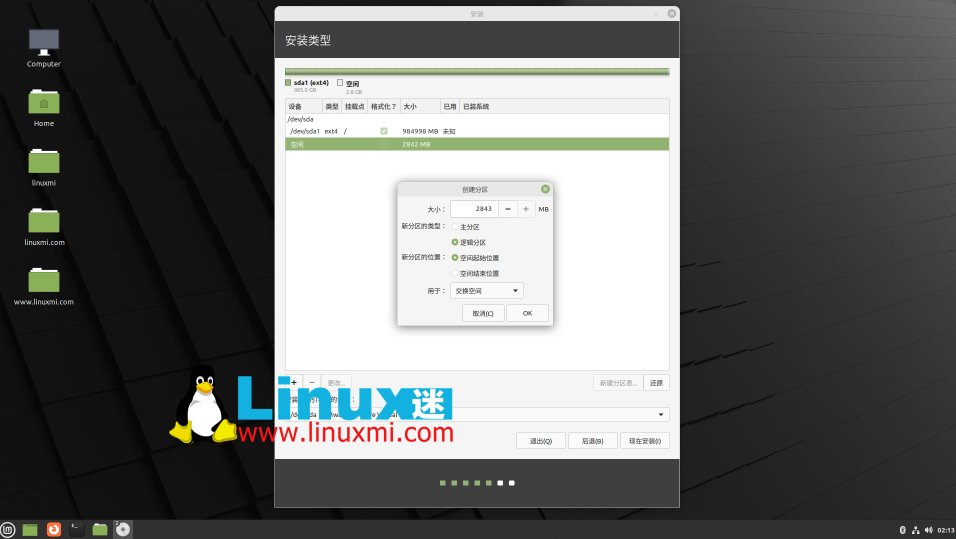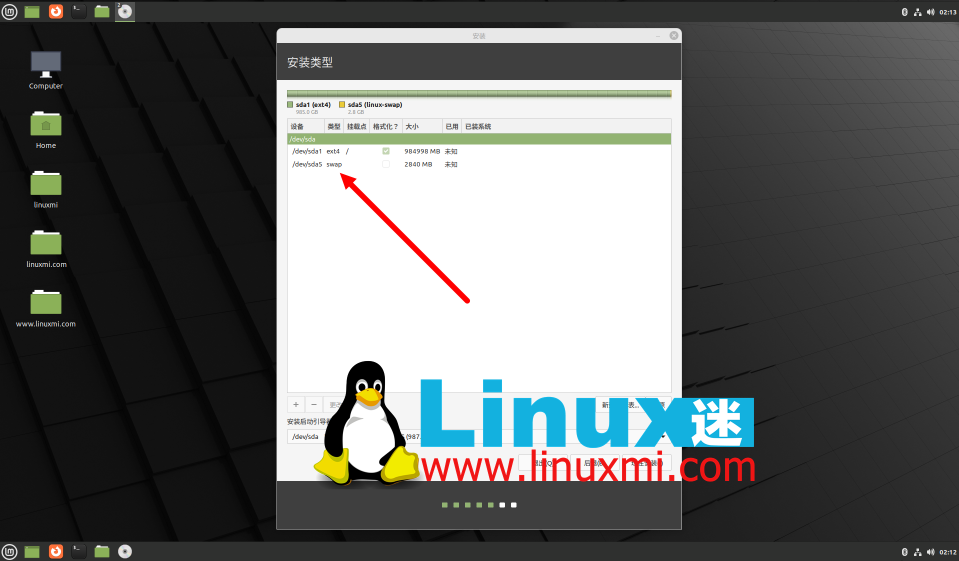Learn more about Linux swap and improve your system performance
In the Linux operating system, swap is a very important concept. It can provide additional memory space for the system and improve the performance and stability of the system. However, for many novices, swap may still be a relatively unfamiliar concept and they do not know how to configure and manage it. In this article, we will have an in-depth understanding of Linux swap, so that you can better configure and manage the system's swap space and improve the performance and stability of the system.
If you finally decide to switch from Windows to Linux. About halfway through the installation process, you will see the term "Linux Swap" and if you want to know what it is, then check out this article. Let’s see what swap space is in Linux and whether it is essential.
What is Swap in Linux?
Swap is similar to the memory expansion feature on smartphones that some manufacturers have recently offered. In short, it uses the phone's internal storage (like RAM) if there's not enough actual RAM space. Likewise, on Linux, swap space prevents your computer from crashing if your physical RAM is full by storing volatile data on its internal storage (HDD/SSD).
Creating swap space is not necessary for installing Linux, but if your computer has less RAM and more storage space, you can save some to make some swap space, as it is in some cases Might come in handy.
How much space is created for swap?
So, if your computer has the features we mentioned above, creating swap space is not bad, but the question is, how much should you create?
There is of course no limit to how much swap you can create, but common wisdom is "half the memory size". However, only create swap if you're sure you'll be running memory-intensive programs and doing a lot of multitasking, otherwise you'll actually be wasting storage space that you could be using to store other things.
How to create swap in Linux?
Considering that you are already in the installer and have created the / and /home partitions, the next step will be to create swap space. All you need to do is create an empty partition of a size that depends on how much RAM you have (if you have 8GB of RAM, you'll need at least 2GB to 4GB of swap space). In the options, select "Use this as exchange" or any exchange-related word and click Create. You can then proceed with the installation process.


Do you have a swap partition installed in your Linux? Let us know in the comments section below.
Through the introduction of this article, I believe you have a deeper understanding of Linux swap and know how to configure and manage it. In the process of using a Linux system, swap is a very important concept. It can provide additional memory space for the system and improve the performance and stability of the system. Therefore, don’t ignore the importance of swap. Properly configuring and managing swap space will bring significant performance improvements to your system.
The above is the detailed content of Learn more about Linux swap and improve your system performance. For more information, please follow other related articles on the PHP Chinese website!

Hot AI Tools

Undresser.AI Undress
AI-powered app for creating realistic nude photos

AI Clothes Remover
Online AI tool for removing clothes from photos.

Undress AI Tool
Undress images for free

Clothoff.io
AI clothes remover

AI Hentai Generator
Generate AI Hentai for free.

Hot Article

Hot Tools

Notepad++7.3.1
Easy-to-use and free code editor

SublimeText3 Chinese version
Chinese version, very easy to use

Zend Studio 13.0.1
Powerful PHP integrated development environment

Dreamweaver CS6
Visual web development tools

SublimeText3 Mac version
God-level code editing software (SublimeText3)

Hot Topics
 deepseek web version entrance deepseek official website entrance
Feb 19, 2025 pm 04:54 PM
deepseek web version entrance deepseek official website entrance
Feb 19, 2025 pm 04:54 PM
DeepSeek is a powerful intelligent search and analysis tool that provides two access methods: web version and official website. The web version is convenient and efficient, and can be used without installation; the official website provides comprehensive product information, download resources and support services. Whether individuals or corporate users, they can easily obtain and analyze massive data through DeepSeek to improve work efficiency, assist decision-making and promote innovation.
 How to install deepseek
Feb 19, 2025 pm 05:48 PM
How to install deepseek
Feb 19, 2025 pm 05:48 PM
There are many ways to install DeepSeek, including: compile from source (for experienced developers) using precompiled packages (for Windows users) using Docker containers (for most convenient, no need to worry about compatibility) No matter which method you choose, Please read the official documents carefully and prepare them fully to avoid unnecessary trouble.
 Ouyi okx installation package is directly included
Feb 21, 2025 pm 08:00 PM
Ouyi okx installation package is directly included
Feb 21, 2025 pm 08:00 PM
Ouyi OKX, the world's leading digital asset exchange, has now launched an official installation package to provide a safe and convenient trading experience. The OKX installation package of Ouyi does not need to be accessed through a browser. It can directly install independent applications on the device, creating a stable and efficient trading platform for users. The installation process is simple and easy to understand. Users only need to download the latest version of the installation package and follow the prompts to complete the installation step by step.
 BITGet official website installation (2025 beginner's guide)
Feb 21, 2025 pm 08:42 PM
BITGet official website installation (2025 beginner's guide)
Feb 21, 2025 pm 08:42 PM
BITGet is a cryptocurrency exchange that provides a variety of trading services including spot trading, contract trading and derivatives. Founded in 2018, the exchange is headquartered in Singapore and is committed to providing users with a safe and reliable trading platform. BITGet offers a variety of trading pairs, including BTC/USDT, ETH/USDT and XRP/USDT. Additionally, the exchange has a reputation for security and liquidity and offers a variety of features such as premium order types, leveraged trading and 24/7 customer support.
 Get the gate.io installation package for free
Feb 21, 2025 pm 08:21 PM
Get the gate.io installation package for free
Feb 21, 2025 pm 08:21 PM
Gate.io is a popular cryptocurrency exchange that users can use by downloading its installation package and installing it on their devices. The steps to obtain the installation package are as follows: Visit the official website of Gate.io, click "Download", select the corresponding operating system (Windows, Mac or Linux), and download the installation package to your computer. It is recommended to temporarily disable antivirus software or firewall during installation to ensure smooth installation. After completion, the user needs to create a Gate.io account to start using it.
 Ouyi Exchange Download Official Portal
Feb 21, 2025 pm 07:51 PM
Ouyi Exchange Download Official Portal
Feb 21, 2025 pm 07:51 PM
Ouyi, also known as OKX, is a world-leading cryptocurrency trading platform. The article provides a download portal for Ouyi's official installation package, which facilitates users to install Ouyi client on different devices. This installation package supports Windows, Mac, Android and iOS systems. Users can choose the corresponding version to download according to their device type. After the installation is completed, users can register or log in to the Ouyi account, start trading cryptocurrencies and enjoy other services provided by the platform.
 Why does an error occur when installing an extension using PECL in a Docker environment? How to solve it?
Apr 01, 2025 pm 03:06 PM
Why does an error occur when installing an extension using PECL in a Docker environment? How to solve it?
Apr 01, 2025 pm 03:06 PM
Causes and solutions for errors when using PECL to install extensions in Docker environment When using Docker environment, we often encounter some headaches...
 gate.io official website registration installation package link
Feb 21, 2025 pm 08:15 PM
gate.io official website registration installation package link
Feb 21, 2025 pm 08:15 PM
Gate.io is a highly acclaimed cryptocurrency trading platform known for its extensive token selection, low transaction fees and a user-friendly interface. With its advanced security features and excellent customer service, Gate.io provides traders with a reliable and convenient cryptocurrency trading environment. If you want to join Gate.io, please click the link provided to download the official registration installation package to start your cryptocurrency trading journey.






